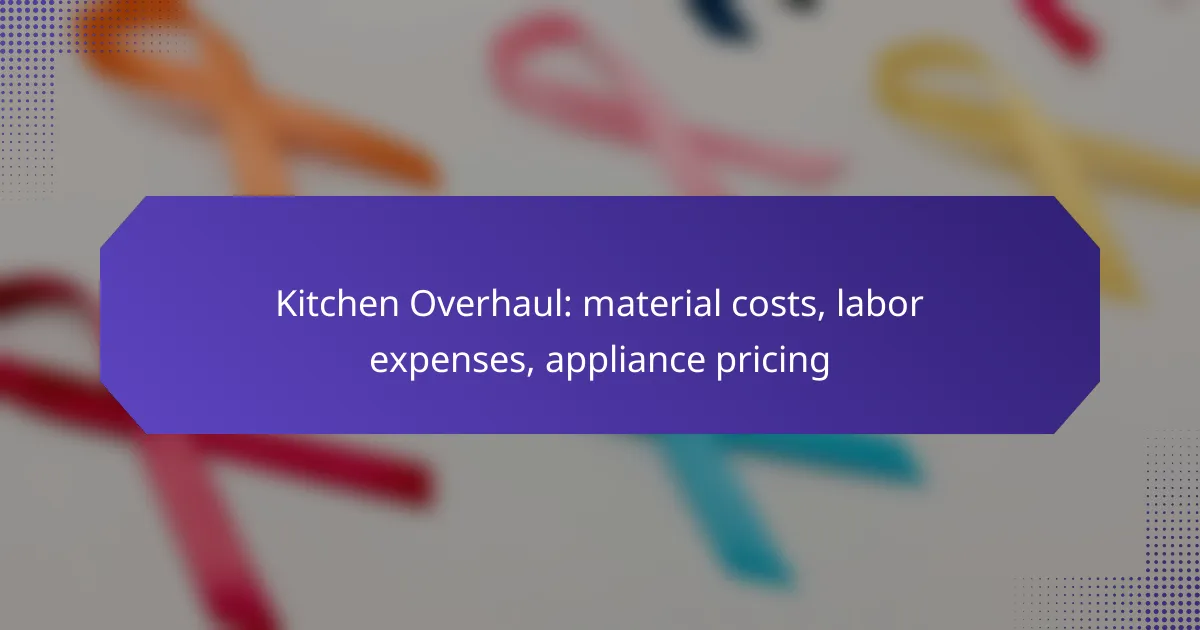Embarking on a kitchen overhaul involves careful consideration of material costs, labor expenses, and appliance pricing. In Los Angeles, the price of materials can range from a few thousand to tens of thousands of dollars, influenced by quality and installation needs. Labor costs also play a crucial role, often comprising a significant portion of the renovation budget. Additionally, kitchen appliances can vary widely in price, with complete sets costing anywhere from a few hundred to several thousand dollars, depending on the features and brands selected.

What are the costs of kitchen materials in Los Angeles?
The costs of kitchen materials in Los Angeles can vary significantly based on quality, brand, and installation requirements. Homeowners should expect to spend anywhere from a few thousand to tens of thousands of dollars depending on their choices.
Granite countertops pricing
Granite countertops in Los Angeles typically range from $50 to $150 per square foot, including installation. Factors influencing the price include the granite’s origin, thickness, and finish. Higher-end options may feature unique patterns or custom edges, which can increase costs significantly.
When selecting granite, consider the maintenance involved, as some finishes may require periodic sealing to maintain their appearance. It’s advisable to obtain multiple quotes from suppliers to ensure competitive pricing.
Cabinet materials costs
Cabinet materials can vary widely in price, with stock cabinets starting around $100 per linear foot and custom options reaching $1,000 or more per linear foot. Common materials include plywood, particleboard, and solid wood, each affecting both durability and cost.
Investing in higher-quality materials can enhance the longevity of your cabinets. Consider the finish and hardware as well, as these can add to the overall expense but also significantly impact the kitchen’s aesthetic.
Flooring options and prices
Flooring prices in Los Angeles can range from $2 to $15 per square foot, depending on the material chosen. Popular options include tile, hardwood, laminate, and vinyl, each offering different benefits in terms of durability and maintenance.
When selecting flooring, think about the kitchen’s traffic and moisture levels. For instance, tile is excellent for high-moisture areas, while hardwood offers warmth but may require more care. Always factor in installation costs, which can add another $2 to $5 per square foot.

How much do labor expenses impact kitchen renovations?
Labor expenses significantly influence the overall cost of kitchen renovations, often accounting for a substantial portion of the budget. Understanding these costs is essential for effective planning and can help homeowners make informed decisions about their projects.
Average contractor fees
The average contractor fees for kitchen renovations can vary widely based on location, project complexity, and contractor experience. Typically, homeowners might expect to pay anywhere from 10% to 20% of the total renovation cost for contractor services. For a mid-range kitchen remodel, this could translate to several thousand dollars in fees.
Labor costs per hour in California
In California, labor costs for kitchen renovations generally range from $50 to $150 per hour, depending on the type of work being performed and the contractor’s expertise. Skilled trades like electricians and plumbers may charge on the higher end of this spectrum, while general laborers may be at the lower end. Always request detailed estimates to understand the breakdown of these costs.
Factors affecting labor expenses
Several factors can influence labor expenses during kitchen renovations. The complexity of the project, the need for specialized skills, and the duration of the work all play significant roles. Additionally, local market conditions and demand for skilled labor can lead to fluctuations in pricing.
Homeowners should also consider the timing of their renovation. Scheduling work during peak seasons may result in higher labor costs due to increased demand. To manage expenses, it may be beneficial to plan renovations during off-peak times or to obtain multiple quotes from contractors to ensure competitive pricing.

What is the pricing for kitchen appliances?
The pricing for kitchen appliances varies widely based on brand, features, and energy efficiency. Generally, you can expect to spend anywhere from a few hundred to several thousand dollars for a complete set of appliances, depending on your choices.
Refrigerator price ranges
Refrigerators typically range from around $500 to over $3,000. Basic models with fewer features are on the lower end, while high-end options with advanced technology, such as smart features and energy efficiency ratings, can be significantly more expensive.
When selecting a refrigerator, consider size, style (top-freezer, bottom-freezer, side-by-side, or French door), and energy consumption. Energy-efficient models may have higher upfront costs but can save you money on utility bills over time.
Oven and stove costs
The cost of ovens and stoves generally falls between $400 and $2,500. Basic electric or gas ranges are more affordable, while professional-grade models with multiple features and larger capacities can be quite pricey.
When purchasing an oven or stove, consider whether you prefer gas or electric, as this can impact installation costs and energy usage. Additionally, look for features like self-cleaning options, convection cooking, and smart technology that can enhance your cooking experience.
Dishwasher pricing
Dishwashers usually range from about $300 to $1,500. Entry-level models are budget-friendly but may lack advanced features, while high-end dishwashers offer quiet operation, energy efficiency, and specialized wash cycles.
When choosing a dishwasher, evaluate its capacity, noise level, and energy ratings. Investing in a more efficient model can lead to savings on water and electricity bills, making it a worthwhile consideration for your kitchen overhaul.

How can I budget for a kitchen overhaul?
Budgeting for a kitchen overhaul involves estimating costs for materials, labor, and appliances, while also considering your overall financial capacity. A well-structured budget helps prioritize spending and avoid unexpected expenses during the renovation process.
Creating a renovation budget
Start by determining your total budget based on your financial situation and how much you can allocate for the kitchen overhaul. It’s advisable to set aside an additional 10-20% of your budget for unexpected costs that may arise during the renovation.
Next, research the average costs for materials, labor, and appliances in your area. This will provide a realistic framework for your budget, allowing you to make informed decisions about where to splurge and where to save.
Cost breakdown by category
When budgeting for your kitchen overhaul, categorize your expenses into three main areas: materials, labor, and appliances. Materials typically include cabinets, countertops, flooring, and fixtures, which can range from a few thousand to tens of thousands of dollars depending on quality and design.
Labor costs can vary significantly based on the complexity of the project and local rates. On average, labor can account for 20-35% of your total budget. It’s essential to get multiple quotes from contractors to ensure competitive pricing.
Lastly, consider appliance pricing, which can also vary widely. Basic appliances may cost a few hundred dollars each, while high-end models can reach thousands. Allocate a portion of your budget specifically for appliances, keeping in mind that energy-efficient options may save you money in the long run.

What are the key factors to consider when choosing materials?
When selecting materials for a kitchen overhaul, consider durability, maintenance needs, and how well they fit your desired style. These factors significantly impact both the longevity of your kitchen and the overall aesthetic appeal.
Durability and maintenance
Durability is crucial in a kitchen, where materials face heat, moisture, and heavy use. Opt for materials like quartz or granite for countertops, which can withstand wear and tear better than softer options like laminate.
Maintenance is another key consideration. Some materials, such as stainless steel, are easy to clean but may show fingerprints, while others, like natural stone, require sealing to prevent stains. Assess how much time you are willing to invest in upkeep when making your choice.
Style and design compatibility
Choosing materials that align with your kitchen’s style is essential for a cohesive look. For modern designs, sleek finishes like glass or polished metals work well, while rustic styles may benefit from wood or stone elements.
Consider the color palette and textures of your existing space. If your kitchen features warm tones, materials in similar hues will create harmony. Additionally, think about how your choices will complement appliances and fixtures to achieve a unified design.

What are the best practices for hiring contractors?
Hiring contractors effectively involves thorough research and clear communication. Prioritize finding qualified professionals who have a proven track record and can provide transparent estimates.
Checking references and reviews
Before hiring a contractor, always check their references and online reviews. Look for feedback on their reliability, quality of work, and ability to stay on budget. Websites like Yelp or Angie’s List can provide insights from previous clients.
Ask for at least three references from past projects similar to yours. Contact these references to inquire about their experiences, focusing on aspects like timeliness, professionalism, and problem-solving skills.
Understanding contracts and estimates
Carefully review all contracts and estimates before signing. Ensure that the scope of work, materials, and timelines are clearly defined to avoid misunderstandings later. A detailed estimate should break down costs for labor, materials, and any additional fees.
Pay attention to payment terms and conditions. It’s common to pay a deposit upfront, but avoid paying the full amount until the project is completed to your satisfaction. Consider including a clause for handling unforeseen issues that may arise during the project.

What are the emerging trends in kitchen design?
Emerging trends in kitchen design focus on sustainability, technology integration, and personalized spaces. Homeowners are increasingly looking for eco-friendly materials and smart appliances that enhance functionality while reflecting their individual style.
Sustainable materials usage
Sustainable materials are becoming a priority in kitchen design, with options such as bamboo, reclaimed wood, and recycled metals gaining popularity. These materials not only reduce environmental impact but also add unique character to the space.
When selecting sustainable materials, consider certifications like FSC (Forest Stewardship Council) for wood products and look for low-VOC (volatile organic compounds) finishes. This ensures that your kitchen is not only stylish but also healthier for your home environment.
Smart kitchen technology integration
Smart kitchen technology is revolutionizing how we cook and manage our kitchens. Devices like smart refrigerators, voice-activated assistants, and app-controlled ovens streamline meal preparation and enhance energy efficiency.
To effectively integrate smart technology, assess your cooking habits and choose appliances that fit your lifestyle. For example, a smart oven can help you monitor cooking times remotely, while a smart fridge can track inventory and suggest recipes based on available ingredients.










